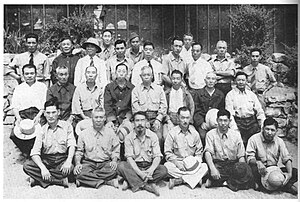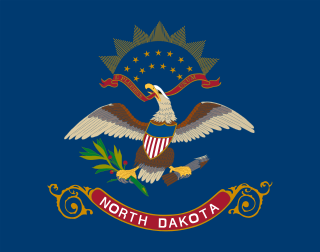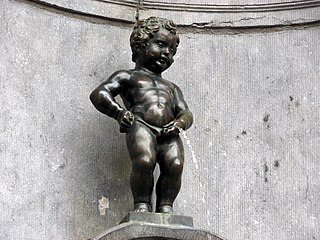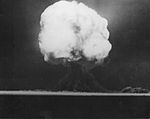
The internment of Japanese Americans in the United States during World War II was the forced relocation and incarceration in concentration camps in the western interior of the country of between 110,000 and 120,000 people of Japanese ancestry, most of whom lived on the Pacific coast. Sixty-two percent of the internees were United States citizens. These actions were ordered by President Franklin D. Roosevelt shortly after Imperial Japan's attack on Pearl Harbor.

Helmbrechts concentration camp was a women's subcamp of the Flossenbürg concentration camp founded near Hof, Germany in the summer of 1944. The first prisoners who came to the camp were political prisoners from the Ravensbrück camp in northern Germany.

The Topaz War Relocation Center, also known as the Central Utah Relocation Center (Topaz) and briefly as the Abraham Relocation Center, was an internment camp which housed Americans of Japanese descent and immigrants who had come to the United States from Japan, called Nikkei. President Franklin Roosevelt signed Executive Order 9066 in February 1942, ordering people of Japanese ancestry to be incarcerated in "relocation centers" like Topaz during World War II. Most of the people interred at Topaz came from the Tanforan Assembly Center and previously lived in the San Francisco Bay Area. The camp was opened in September 1942 and closed in October 1945.
A civilian internee is a civilian detained by a party to a war for security reasons. Internees are usually forced to reside in internment camps, often pejoratively called concentration camps and similar to prisoner of war camps or civilian prisons. Historical examples include Japanese American internment and internment of German Americans in the United States during World War II. Japan interned 130,000 Dutch, British, and American civilians in Asia during World War II.
Ilag is an abbreviation of the German word Internierungslager. They were internment camps established by the German Army in World War II to hold Allied civilians, caught in areas that were occupied by the German Army. They included United States citizens caught in Europe by surprise when war was declared in December 1941 and citizens of the British Commonwealth caught in areas engulfed by the Blitzkrieg.

Batu Lintang camp at Kuching, Sarawak on the island of Borneo was a Japanese internment camp during the Second World War. It was unusual in that it housed both Allied prisoners of war (POWs) and civilian internees. The camp, which operated from March 1942 until the liberation of the camp in September 1945, was housed in buildings that were originally British Indian Army barracks. The original area was extended by the Japanese, until it covered about 50 acres. The camp population fluctuated, due to movement of prisoners between camps in Borneo, and as a result of the deaths of the prisoners. It had a maximum population of some 3,000 prisoners.

The Torrens Island Internment Camp was a World War I concentration camp, located on Torrens Island in the Port River Estuary near Adelaide in South Australia. The camp opened on 9 October 1914 and held up to 400 men of German or Austro-Hungarian background, or crew members of enemy ships who had been caught in Australian ports at the beginning of the war. They were held without trial under the provisions of the War Precautions Act 1914.

The Weihsien Internment Camp was a Japanese operated ”Civilian Assembly Center” in the former Wei County, located in the present-day city of Weifang, Shandong, China. The compound was a Japanese-run internment camp created during World War II to hold civilians of Allied countries living in North China. The camp's population initially included British, Canadian, American, Australian, Dutch, Belgian and other citizens. An additional group of Italian internees arrived in the camp on December 30, 1943, after the allied invasion of Sicily and the fall of Mussolini. In total, Weihsien remained in operation after the Japanese invasion until American forces liberated the camp on August 17, 1945. Information on Weihsien has been learned through papers, diaries, official reports and letters written by internees, family members, and other people affected.

The Hay Internment and POW camps at Hay, New South Wales, Australia were established during World War II as prisoner-of-war and internment centres, due in no small measure to the isolated location of the town. Three high-security camps were constructed in 1940. The first arrivals were over two thousand refugees from Nazi Germany and Austria, most of whom were Jewish; they had been interned in the United Kingdom when fears of an armed invasion of Britain were at their peak. The British government then made the decision to forcibly transport these refugees to Australia on the HMT Dunera. The internees were kept in conditions on board the Dunera that were cruel and inhumane, and after the war the Dunera story became quite infamous, leading the British government to apologise for their egregious mistreatment of innocent civilian refugees. The internees arrived at Hay on 7 September 1940 by four trains from Sydney. They were interned in Camps 7 and 8 under the guard of the 16th Garrison Battalion of the Australian Army. In November 1940 the other compound at Hay, Camp 6, was occupied by Italian civilian internees. Camps 7 and 8 were vacated in May 1941 when the Dunera internees left Hay; some were sent to Orange (NSW), others to Tatura in Victoria, and others to join the Pioneer Corps of the Australian Army. Upon their departure Italian prisoners-of-war were placed in Camps 7 and 8. In December 1941 Japanese internees were conveyed to Hay and placed in Camp 6. In April 1942 the River Farm began operating on the eastern edge of the township, enabling market-gardening and other farm activities to be carried out by the Italian internees and POWs. In February 1945, in the wake of the Cowra POW break-out, a large number of Japanese POWs were transferred to Hay and placed in the three high-security compounds. On 1 March 1946 the Japanese POWs departed from Hay in five trains, transferred to Tatura. During 1946 the Italians who remained at Hay were progressively released or transferred to other camps, and the Hay camps were dismantled and building materials and fittings sold off by June the following year.

Santo Tomas Internment Camp, also known as the Manila Internment Camp, was the largest of several camps in the Philippines in which the Japanese interned enemy civilians, mostly Americans, in World War II. The campus of the University of Santo Tomas in Manila was utilized for the camp, which housed more than 3,000 internees from January 1942 until February 1945. Conditions for the internees deteriorated during the war and by the time of the liberation of the camp by the U.S. Army many of the internees were near death from lack of food.

The history of Arizona during World War II begins in 1940, when the United States government began constructing military bases within the state in preparation for war. Although far removed from the frontlines in Europe and the Pacific, Arizona's contribution to the Allied war effort was significant. Multiple prisoner of war camps and Japanese internment camps were established across the state, as well as several new airbases and associated sites, resulting in the birth of Arizona's aviation and manufacturing industries at the end of the Depression-era. The population of the state also experienced a major increase; many veterans returned to Arizona after the war ended in 1945, laying the foundations for the large metropolises of Phoenix and Tucson.

The Escape from Fort Stanton occurred on November 1, 1942, when four German sailors escaped from an internment camp at Fort Stanton, New Mexico. There were other minor escape attempts from the fort, however, the incident in November 1942 was the most successful and the only one to end with a shootout. One German was wounded as result and the three remaining prisoners were sent back to Fort Stanton.
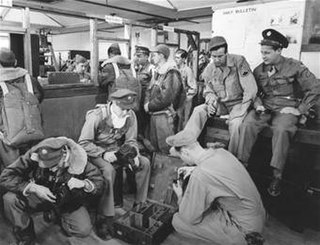
The history of New Mexico during World War II was a period of dramatic change. After America's entry into World War II in 1941, New Mexico became a center for the development of nuclear weapons and an important base for the United States Army. The state's population grew significantly both during the war and in the decades afterwards, a period known as the "Boom Years" in New Mexican history. In 1940, there were just over 530,000 people living in New Mexico and by 1960 there was over 950,000. The development of modern military technology also created a unique relationship between New Mexico, the federal government, and the scientific community, which still exists today.

The Santa Fe riot was a confrontation at a Japanese internment camp near Santa Fe, New Mexico, during World War II. On March 12, 1945, approximately 275 internees assembled in Camp Santa Fe to watch and protest the removal of three men to another camp. During which, a scuffle broke out between the internees and the Border Patrol agents who were guarding the facility, resulting in the use of tear gas grenades, batons, and the serious injury of four internees.

Wauwilermoos was an internment camp and prisoner-of-war penal camp in Switzerland during World War II. It was situated in the municipalities of Wauwil and Egolzwil in the Canton of Lucerne (Luzern). Established in 1940, Wauwilermoos was a penal camp for internees, including Allied soldiers, among them members of the United States Army Air Forces, who were sentenced for attempting to escape from other Swiss camps for interned soldiers, or other offences. Together with Hünenberg and Les Diablerets, Wauwilermoos was one of three Swiss penal camps for internees that were established in Switzerland during World War II. The intolerable conditions were later described by numerous former inmates and by various contemporary reports and studies.

Camp Holmes Internment Camp, also known as Camp #3 and Baguio Internment Camp, near Baguio in the Philippines was established in World War II by the Japanese to intern civilians from countries hostile to Japan. The camp housed about 500 civilians, mostly Americans, between April 1942 and December 1944 when the internees were moved to Bilibid Prison in Manila. Camp Holmes was a Philippine Constabulary base before World War II and later was renamed Camp Bado Dangwa and became a base for the Philippine National Police. It is located near what is now the Halsema Highway.
Yoshiaki Fukuda was a Konko bishop and missionary. He founded the Konko-kyo Church of San Francisco in 1930 and was the head of the Konko Federation in North America. He was considered a Group A prisoner during World War II and was a vocal leader for Japanese prisoners during the internment of Japanese Americans.
